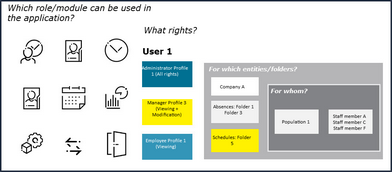User rights
User rights administration can be accessed from the Administrator workspace > User rights navigation menu.
|
It is possible to add a shortcut to your portal. |
The rights module lets you set up the rights for Kelio software users. It can be accessed from any workstation connected to the network. It lets you configure:
•Rights profiles,
•the system Users, by assigning rights profiles,
•the Populations that certain users can manage,
•the rules for managing software access.
List of profiles
Each employee who uses the Kelio system is a user, whether they are just an employee who clocks in and out using the software or an administrator who uses Kelio software’s advanced features. All of them are users who have different rights. In Kelio, the rights are divided into thirteen headings, each of which corresponds to a software functional module:
Administrator - Access administration Administrator - Staff administration Administrator - Time activities Employee - Employee Self-Service Employee - Mobile Self-Service |
Operating principle
When you create profiles, you can segment the rights for each functional module. When you associate profiles with users, you assign each one the rights he/she requires for the modules he/she wants. For certain profiles, you must define the employee population and the entities/folders to which these rights must apply. This means that you must first define the organisation chart for the company or the specific employee populations.
For each user you must define:
Recommendations
|
In general, it is best to take the following configuration steps: |
1.Create the organisation chart and populations
You can use populations defined by the system based on the company’s organisation chart. However, various populations covering employees from different departments may be created to make it easier to manage administrator rights.
2.Creating profiles
The profiles, sorted by theme, are used to define groups of rights to the Kelio Suite features.
3.Creating users
Users will have profiles that define their rights and may be associated with organisation charts, employees or population levels if they have an administrator role.



